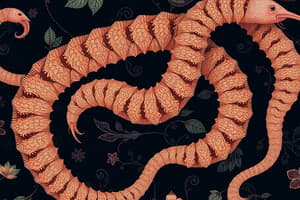Podcast
Questions and Answers
According to embryologist Goodrich, are nephridia and coelomoducts homologous structures?
According to embryologist Goodrich, are nephridia and coelomoducts homologous structures?
No, according to embryologist Goodrich, nephridia and coelomoducts are not homologous but are different structures morphologically.
What are the two types of segmental organs found in Annelida?
What are the two types of segmental organs found in Annelida?
The two types of segmental organs in Annelida are nephridia (derived from ectoderm) and coelomoducts (derived from mesoderm).
How do nephridia function in Annelida?
How do nephridia function in Annelida?
Nephridia remove wastes from the coelom.
What is the origin and structure of nephridia?
What is the origin and structure of nephridia?
How do coelomoducts differ from nephridia in their origin and structure?
How do coelomoducts differ from nephridia in their origin and structure?
What is the function of coelomoducts in Annelida?
What is the function of coelomoducts in Annelida?
What is the difference between protonephridia and metanephridia?
What is the difference between protonephridia and metanephridia?
What are the two types of metanephridia based on size?
What are the two types of metanephridia based on size?
What is the difference between exonephric and enteronephric nephridia?
What is the difference between exonephric and enteronephric nephridia?
What are the three types of nephromixia, and what organisms exhibit them?
What are the three types of nephromixia, and what organisms exhibit them?
How do the arrangements of nephridia and coelomoducts differ between Oligochaeta/Hirudinea and Polychaeta?
How do the arrangements of nephridia and coelomoducts differ between Oligochaeta/Hirudinea and Polychaeta?
Describe the arrangement of nephridia in Hirudinea (leeches).
Describe the arrangement of nephridia in Hirudinea (leeches).
Flashcards are hidden until you start studying
Study Notes
Segmental Organs in Annelida
- Segmental organs, also known as excretory organs, are tubes found in each segment of Annelida individuals, responsible for conducting excretory and reproductive products from the coelom to the outside of the body.
Types of Segmental Organs
- There are two types of segmental organs:
- Nephridia (derived from ectoderm)
- Coelomoducts (derived from mesoderm)
Nephridia
- Nephridia are segmentally arranged, coiled tubes originated from the invagination of ectoderm.
- They are ciliated internally and project into the coelom.
- Nephridia open into a small lateral pore called nephridiopore and may also end blindly.
- They remove wastes from the coelom.
Coelomoducts
- Coelomoducts are segmentally arranged, wide tubes originating from mesoderm as outpouchings from the coelom.
- Their lumen is intercellular.
- Coelomoducts either open to the outside or into the coelom by a large ciliated funnel.
- They are not part of the nephridium proper and are genital ducts derived from the coelomic epithelium, opening to the outside by a genital pore.
Types of Nephridia
- There are two types of nephridia:
- Protonephridia (blindly ending, primitive type)
- Metanephridia (opening into the coelom by a ciliated funnel, found in majority of Polychaeta and Oligochaeta)
Subtypes of Metanephridia
- Metanephridia can be further classified into:
- Micronephridia (microscopic, smaller in size, and numerous in each segment)
- Meganephridia (larger in size, found in two segments, and nephrostomes open into the next segment)
Nephromixia
- Nephromixia refers to compound excretory organs formed by the union of nephridia and coelomoduct.
- They consist of both ectoderm and mesoderm and serve both excretory and reproductive functions.
- There are three types of nephromixia:
- Protonephromixium (formed by the union of coelomoduct with a protonephridium)
- Metanephromixium (formed by the union of coelomoduct with a metanephridium)
- Mixonephridium (formed by the intimate joining of coelomoduct and nephridium)
Studying That Suits You
Use AI to generate personalized quizzes and flashcards to suit your learning preferences.




